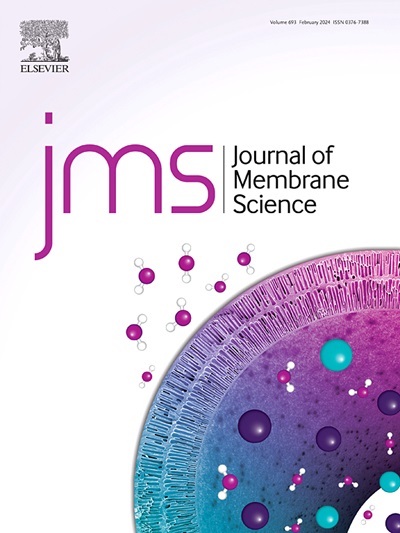High-flux organosilicon membrane with solvent-assisted confined modification for alcohol recovery
IF 8.4
1区 工程技术
Q1 ENGINEERING, CHEMICAL
引用次数: 0
Abstract
The global transition toward renewable energy has intensified the demand for sustainable bio-alcohols, yet their industrial production remains hindered by inefficient recovery from fermentation broths. To address this challenge, we developed a high-performance organosilicon membrane with precisely tunable chain spacing via a solvent-assisted confined modification (SACM) strategy for enhanced alcohol recovery. By utilizing n-hexane as a solvent medium, perfluorooctyl chloride infiltrates the membrane's nanoscale interchain gaps, undergoing an amide reaction with residual amine groups. The SACM approach enables precise control over interchain spacing (3.86–3.92 Å) and enhanced organophilicity, significantly improving recovery efficiency. The optimized membrane demonstrates exceptional performance, with total fluxes of 4.6 and 7.2 kg⋅m−2⋅h−1 for ethanol and n-butanol recovery, respectively, coupled with separation factors of 9.4 and 19.1, surpassing most reported organosilicon membranes. Further investigations into operational conditions, C1–C4 alcohol recovery, and cost analysis underscore its industrial viability. This study not only presents a facile strategy for optimizing alcohol separation but also advances the design of functional membranes for industrial-scale molecular separations.
高通量有机硅膜与溶剂辅助限制改性酒精回收
全球向可再生能源的过渡加剧了对可持续生物醇的需求,但其工业生产仍然受到发酵肉汤回收效率低下的阻碍。为了解决这一挑战,我们通过溶剂辅助限制性修饰(SACM)策略开发了一种具有精确可调链间距的高性能有机硅膜,以提高酒精回收率。利用正己烷作为溶剂介质,全氟辛基氯渗透到膜的纳米级链间隙中,与残留的胺基发生酰胺反应。SACM方法可以精确控制链间间距(3.86-3.92 Å),并增强亲有机物性,显著提高采收率。优化后的膜具有优异的性能,乙醇和正丁醇的总通量分别为4.6和7.2 kg⋅m−2⋅h−1,分离系数为9.4和19.1,超过了大多数已有的有机硅膜。对操作条件、C1-C4酒精回收和成本分析的进一步调查强调了其工业可行性。这项研究不仅提出了一种优化醇分离的简单策略,而且还推动了工业规模分子分离功能膜的设计。
本文章由计算机程序翻译,如有差异,请以英文原文为准。
求助全文
约1分钟内获得全文
求助全文
来源期刊

Journal of Membrane Science
工程技术-高分子科学
CiteScore
17.10
自引率
17.90%
发文量
1031
审稿时长
2.5 months
期刊介绍:
The Journal of Membrane Science is a publication that focuses on membrane systems and is aimed at academic and industrial chemists, chemical engineers, materials scientists, and membranologists. It publishes original research and reviews on various aspects of membrane transport, membrane formation/structure, fouling, module/process design, and processes/applications. The journal primarily focuses on the structure, function, and performance of non-biological membranes but also includes papers that relate to biological membranes. The Journal of Membrane Science publishes Full Text Papers, State-of-the-Art Reviews, Letters to the Editor, and Perspectives.
 求助内容:
求助内容: 应助结果提醒方式:
应助结果提醒方式:


